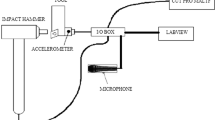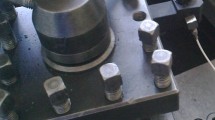Abstract
Chatter vibration is a condition which hinders effective performance of material removal in machining operations. This kind of vibration is dangerous and leads to over-vibration between workpiece and tool. Additionally, it results in low surface quality, loudness and excessive tool wear. In order to prevent the chatter vibration, there are different methods in the literature by which vibration can be effectively controlled. The aim of this study is to determine the optimum parameters of chatter vibrations in turning process and develop a hybrid decision-making algorithm which consists of artificial neural networks–TOPSIS methods for the optimization of machining parameters. First, stable cutting depths, chatter frequencies and other modal parameters are determined by an empirical study. Then, a new hybrid decision-making model is developed and optimum machining parameters are determined. It is observed that the hybrid decision-making model produces successful results and chatter vibrations are prevented.






Similar content being viewed by others
References
Altintas Y, Budak E (1995) Analytical prediction of stability lobes in milling. CIRP Ann Manuf Technol 44:357–362
Antony J (2014) Design of experiments for engineers and scientists. Elsevier, Amsterdam
Ariffin MKA, Sims ND, Worden K (2004) Genetic optimization of machine tool paths. In: 6th international conference on adaptive computing in design and manufacture in ‘adaptive computing in design and manufacture VI’, Bristol. Springer, Berlin
Bachrathy D, Stepan G (2013) Improved prediction of stability lobes with extended multi frequency solution. CIRP Ann Manuf Technol 62:411–414
Balakrishnan P, DeVries MF (1985) Sequential estimation of machinability parameters for adaptive optimization of machinability database systems. J Eng Ind 107:159–166
Baskar N, Asokan P, Prabhaharan G, Saravanan R (2005) Optimization of machining parameters for milling operations using non-conventional methods. Int J Adv Manuf Technol 25(11):1078–1088
Baskar N, Asokan P, Saravanan R, Prabhaharan G (2006) Selection of optimal machining parameters for multi-tool milling operations using a memetic algorithm. J Mater Process Technol 174(1):239–249
Breda D, Maset S, Vermiglio R (2014) Pseudo spectral methods for stability analysis of delayed dynamical systems. Int J Dyn Control 2:143–153
Breda D, Maset S, Vermiglio R (2015) Stability of linear delay differential equations. Springer, NewYork
Chang CK, Lu H (2007) Design optimization of cutting parameters for side milling operations with multiple performance characteristics. Int J Adv Manuf Technol 32(1):18–26
Chua MS, Loh HT, Wong YS, Rahman M (1991) Optimization of cutting conditions for multi-pass turning operations using sequential quadratic programming. J Mater Process Technol 28(1–2):253–262
Ding Y, Zhu LM, Zhang XJ, Ding H (2010) A full discretization method for prediction of milling stability. Int J Mach Tools Manuf 50:502–509
Insperger T, Stepan G (2002a) Semi discretization method for delayed systems. Int J Numer Methods Eng 55:503–518
Khasawneh FA, Mann B (2013) A spectral element approach for the stability analysis of time periodic delay equations with multiple delays. Commun Nonlinear Sci Numer Simul 18:2129–2141
Merdol SD, Altintas Y (2004) Multi frequency solution of chatter stability for low immersion milling. J Manuf Sci Eng ASME 126:459–466
Meritt HE (1965) Theory of self-excited machine-tool chatter. Trans ASME J Eng Ind 87:447–454
Oktem H, Erzurumlu T, Erzincanli F (2006) Prediction of minimum surface roughness in end milling mold parts using neural network and genetic algorithm. Mater Des 27(9):735–744
Quintana G, Ciurana J (2011) Chatter in machining processes: a review. Int J Mach Tools Manuf 51:363–376. doi:10.1016/j.ijmachtools.2011.01.001
Rosenthal G, Rosenthal JA (2011) Statistics and data interpretation for social work. Springer, Berlin
Siddhpura M, Paurobally R (2012) A review of chatter vibration research in turning. Int J Mach Tools Manuf 61:27–47. doi:10.1016/j.ijmachtools.2012.05.007
Sofuoglu MA, Orak S (2015) A hybrid decision making approach to prevent chatter vibrations. Appl Soft Comput 37:180–195. doi:10.1016/j.asoc.2015.08.018
Stoic A, Kopac J, Cukor G (2005) Testing of machinability of mould steel 40CrMnMo7 using genetic algorithm. J Mater Process Technol 164–165:1624–1630
Tobias SA (1965) Machine tool vibration. Blackie, London
Totis G, Albertelli P, Sortino M, Monno M (2014) Efficient evaluation of process stability in milling with spindle speed variation by using the Chebyshev collocation method. J Sound Vib 333:646–668
Türkeş E (2007) Theoretical and experimental analysis of process damping in machine tool chatter vibration. Doctoral Dissertation, Department of Mechanical Engineering, Eskisehir Osmangazi University
Tzeng G-H, Huang J-J (2011) Multiple attribute decision making: methods and applications. CRC Press, Boca Raton
Wang ZG, Rahman M, Wong YS, Sun J (2005) Optimization of multi-pass milling using parallel genetic algorithm and parallel genetic simulated annealing. Int J Mach Tools Manuf 45(15):1726–1734
Yegnanarayana B (2009) Artificial neural networks. PHI Learning Pvt Ltd, New Delhi
Yeo SH, Rahman M, Wong YS (1995) A tandem approach to selection of machinability data. Int J Adv Manuf Technol 10(2):79–86
Acknowledgements
The author M. Alper Sofuoğlu was supported by TÜBİTAK 2228-B, and this study was supported by TÜBİTAK (Project No.: 115M123).
Author information
Authors and Affiliations
Corresponding author
Ethics declarations
Conflict of interest
The authors declare that they have no conflict of interest.
Additional information
Communicated by V. Loia.
Appendix
Rights and permissions
About this article
Cite this article
Orak, S., Arapoğlu, R.A. & Sofuoğlu, M.A. Development of an ANN-based decision-making method for determining optimum parameters in turning operation. Soft Comput 22, 6157–6170 (2018). https://doi.org/10.1007/s00500-017-2682-8
Published:
Issue Date:
DOI: https://doi.org/10.1007/s00500-017-2682-8




